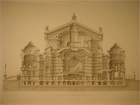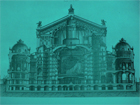The Paris Opera, a common law institution
As a result of a law passed in 1939, the new Opera status entered the institution into the common law of state public institutions (“établissement public”). Most historians believe that the Paris Opera has experienced between 1939 and 1994 a dark period of its history, despite some brilliant and historic productions, of Carmen and Les Indes galantes in particular. Throughout Europe, artistic and technical production methods for lyrical have changed in depth from the end of the sixties. Demand for quality has grown stronger.
The work describes the main aspects of these changes.
A dark period up to the end of the 1960s
For technical reasons (a stage that was not designed for alternating performances), administrative reasons (strict, badly-functioning guardianship of the state administration, the director's precarious status, more inclination for putting on performances than running the theatre), financial reasons (high costs), the Paris Opera was collapsing when the decision was taken to call in Rolf Liebermann at the end of the 1970s.
Liebermann' bright spell
An exceptional lyrical bright spell occurred from 1973-1980. But the costs increased dramatically. An investigation and proposal committee led in 1977 by François Bloch-Lainé, a high ranked financial civil servant, respected for his integrity and past efficient services, condemned the Palais Garnier as a lyrical theatre because of its costs, which were considered to be excessive, its insufficient seating capacity, and the supposed unreasonable cost of renewing its stage and artistic facilities. The same committee recommended the construction of a theatre with a seating capacity of 3000.This is how the Bastille Opera House project was born. The same François Bloch-Lainé led the team responsible for bringing the project to life from 1981.
Social difficulties
Punctuated by frequent strikes, the working life of the Paris Opera made its way between tensions, crisis but also an improved social dialogue.
Towards a better future but instability from 1989 to 1993
In 1989, the difficult, yet promising opening of the Bastille Opera House takes place. This is a very unstable period of the history of the Paris Opera. The turn over of management is very high. New and more efficient artistic production methods also appear. Jacques Toubon, minister for culture in 1993, asks Hughes Gall to become the director of the Paris Opera who will be able to succeed in reassessing its professional capacity and it’s artistic output. Previously, Hughes Gall had been Liebermann's right hand man, then director of the Grand Théâtre in Geneva since 1980.



